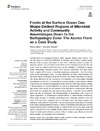Identificador persistente para citar o vincular este elemento:
https://accedacris.ulpgc.es/jspui/handle/10553/23213
| Campo DC | Valor | idioma |
|---|---|---|
| dc.contributor.author | Baltar González, Federico | - |
| dc.contributor.author | Aristegui, J. | - |
| dc.date.accessioned | 2017-08-22T02:34:28Z | - |
| dc.date.accessioned | 2018-03-08T13:06:30Z | - |
| dc.date.available | 2017-08-22T02:34:28Z | - |
| dc.date.available | 2018-03-08T13:06:30Z | - |
| dc.date.issued | 2017 | - |
| dc.identifier.issn | 2296-7745 | - |
| dc.identifier.other | WoS | - |
| dc.identifier.uri | https://accedacris.ulpgc.es/handle/10553/23213 | - |
| dc.description.abstract | Oceanic fronts are widespread features which separate distinct water masses. They are well known to control the distribution of microbial communities in surface waters, although there is scarce information on their role in delimiting critical functions that microbes perform, and on whether their effects can be translated down into the dark ocean. Here we carried out the first study on the variability of hydrolysis of organic matter (extracellular enzymatic activity; EEA) across a permanent front (the Azores Front), coupled with changes in microbial assemblage composition, from the surface down to the bathypelagic zone. | - |
| dc.format | application/pdf | - |
| dc.language | eng | - |
| dc.relation.ispartof | Frontiers in Marine Science | - |
| dc.rights | by-nc-nd | - |
| dc.source | Frontiers in Marine Science [ISSN 2296-7745], v. 4, article number 252 | - |
| dc.subject | 251001 Oceanografía biológica | - |
| dc.subject.other | Azores front | - |
| dc.subject.other | Biogeographical regions | - |
| dc.subject.other | Suspended particle organic matters | - |
| dc.title | Fronts at the surface ocean can shape distinct regions of microbial activity and community assemblages down to the bathypelagic zone: The Azores front as a case study | - |
| dc.type | info:eu-repo/semantics/Article | - |
| dc.type | Article | - |
| dc.identifier.doi | 10.3389/fmars.2017.00252 | - |
| dc.identifier.scopus | 85027098178 | - |
| dc.identifier.isi | 000457690600250 | - |
| dc.contributor.authorscopusid | 23476314200 | - |
| dc.contributor.authorscopusid | 7006816204 | - |
| dc.identifier.crisid | -;2728 | - |
| dc.identifier.eissn | 2296-7745 | - |
| dc.relation.volume | 4 | - |
| dc.investigacion | Ciencias | - |
| dc.project.acronym | CAIBEX (CTM2007-66408-C02-02) “Plan Nacional de I+D” (MEC); FLUXES (CTM2015-69392-C3-1-R) “Plan Nacional de I+D” (MEC) | - |
| dc.rights.accessrights | info:eu-repo/semantics/openAccess | - |
| dc.type2 | Artículo | - |
| dc.contributor.daisngid | 1232580 | - |
| dc.contributor.daisngid | 227201 | - |
| dc.identifier.external | 2728 | - |
| dc.description.numberofpages | 13 | - |
| dc.contributor.wosstandard | WOS:Baltar, F | - |
| dc.contributor.wosstandard | WOS:Aristegui, J | - |
| dc.date.coverdate | Agosto 2017 | - |
| dc.identifier.ulpgc | Sí | es |
| dc.description.sjr | 1,225 | |
| dc.description.sjrq | Q1 | |
| dc.description.scie | SCIE | |
| item.fulltext | Con texto completo | - |
| item.grantfulltext | open | - |
| crisitem.author.dept | GIR IOCAG: Oceanografía Biológica y Algología Aplicada | - |
| crisitem.author.dept | IU de Oceanografía y Cambio Global | - |
| crisitem.author.dept | Departamento de Biología | - |
| crisitem.author.orcid | 0000-0002-7526-7741 | - |
| crisitem.author.parentorg | IU de Oceanografía y Cambio Global | - |
| crisitem.author.fullName | Arístegui Ruiz, Javier | - |
| Colección: | Artículos | |
Citas SCOPUSTM
27
actualizado el 08-jun-2025
Citas de WEB OF SCIENCETM
Citations
27
actualizado el 12-ene-2026
Visitas
66
actualizado el 11-ene-2026
Descargas
128
actualizado el 11-ene-2026
Google ScholarTM
Verifica
Altmetric
Comparte
Exporta metadatos
Los elementos en ULPGC accedaCRIS están protegidos por derechos de autor con todos los derechos reservados, a menos que se indique lo contrario.
